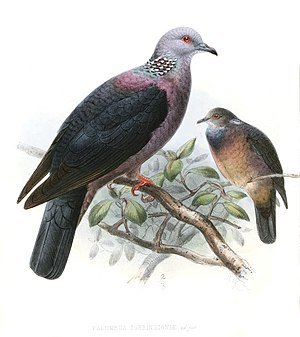Ceylon pigeon
| Ceylon pigeon | ||||||||||
|---|---|---|---|---|---|---|---|---|---|---|

Ceylon pigeon |
||||||||||
| Systematics | ||||||||||
|
||||||||||
| Scientific name | ||||||||||
| Columba torringtoniae | ||||||||||
| ( Blyth & Kelaart , 1853) |
The Ceylon pigeon ( Columba torringtoniae , occasionally also written Columba torringtoni ) is a species of pigeon birds. It occurs exclusively in Southeast Asia.
The population situation of the Ceylon pigeon is given as vulnerable (= endangered).
features
The Ceylon pigeon reaches a body length of 43.8 centimeters and is thus something as big as a small city pigeon , but it has a slightly longer tail. There is no noticeable sexual dimorphism .
In both sexes, the head is gray with a greenish and purple tinge on the crown and on the neck. On the sides of the neck and on the back of the neck there are stiffened black feathers with a white feather tip. This creates a wide, white-spotted collar. The upper coat and the sides of the chest shimmering iridescent purple to greenish. The rest of the coat, the back and the rump are blackish, the individual feathers have narrow, greenish, violet or bronze-colored iridescent hems. The wings are brown. The upper tail covers and the control feathers are black. The throat and chin are light gray, the ear covers are gray-purple. The chest is dark gray-purple. The belly is light, the under tail-covers are gray-beige.
Young birds are generally black-brown on the upper side of the body, the individual feathers on the head and the wing covers are lined with narrow red-brown. The iridescent plumage on the neck and on the coat are only rudimentary.
Possible confusion
The Ceylon pigeon can be confused with rock pigeons and city pigeons . However, both are more compact in physique and have shorter tails. They also lack the Ceylon pigeon's characteristic black and white collar. The bronze fruit pigeon is significantly larger and only occurs in the lowlands. She also lacks the black and white collar. The Oriental turtle dove, on the other hand, has such a collar, but is much smaller and has noticeably scaled back.
Distribution area and habitat
The distribution area of the Ceylon pigeon is Sri Lanka, where it occurs exclusively in the mountains and high altitudes in the south of the island.
The Ceylon pigeon inhabits moist deciduous and evergreen mountain forests. It only breeds at altitudes above 1000 meters, even if seasonally it occasionally comes down to lower altitudes and even at altitudes of 300 meters. It can then be found in the humid tropical rainforests of the island.
Way of life
The Ceylon pigeon is a shy and secretly living pigeon that occurs either solitary, in pairs or in small groups. It only lives in the treetops. Their food spectrum includes fruits and berries. Her occasional migrations to lower altitudes are food-related - she occasionally migrates over greater distances in order to find enough fruit-bearing trees. The breeding season seems to have its peak in October, but breeding pigeons can occasionally be observed until the first few months of the next year. The clutch consists of a single white egg.
Existence and endangerment
The population of the Ceylon pigeon is estimated at a few thousand individuals. The main threat to the pigeon species comes from deforestation, which has meanwhile also reached the mountainous regions of Sri Lanka, and the change in the species composition in the remaining forests. This is due to selective logging, the collection of firewood, the conversion of forest into agricultural areas or plantations, the search for precious stones, the penetration of settlements into forest areas and forest fires. Even forests that are under protection are increasingly being changed by these interventions. The Ceylon pigeon mainly suffers from a reduced food supply because the fruit-bearing trees on which it depends are increasingly disappearing.
literature
- David Gibbs, Eustace Barnes and John Cox: Pigeons and Doves - A Guide to the Pigeons and Doves of the World . Pica Press, Sussex 2001, ISBN 90-74345-26-3 .
- Alois Münst and Josef Wolters: Tauben - The species of wild pigeons , 2nd expanded and revised edition, Verlag Karin Wolters, Bottrop 1999, ISBN 3-9801504-9-6 .
- Gerhard Rösler: The wild pigeons of the earth - free living, keeping and breeding . Verlag M. & H. Schaper, Alfeld Hannover 1996, ISBN 3-7944-0184-0 .
Web links
- Columba torringtoniae in the Red List of Threatened Species of the IUCN 2012. Posted by: BirdLife International, 2012. Accessed October 17, 2016th
Single receipts
- ↑ a b Gibbs, Barnes and Cox: Pigeons and Doves , p. 201.
- ↑ a b c Columba torringtoniae in the endangered Red List species the IUCN 2012. Posted by: BirdLife International, 2012. Accessed October 17, 2016th
- ↑ Gibbs, Barnes and Cox: Pigeons and Doves , p. 202.